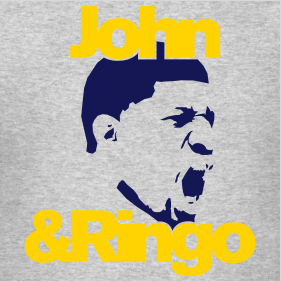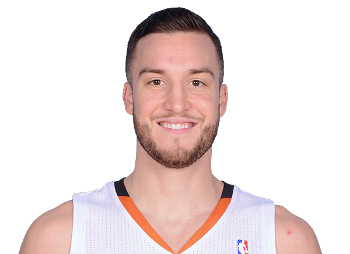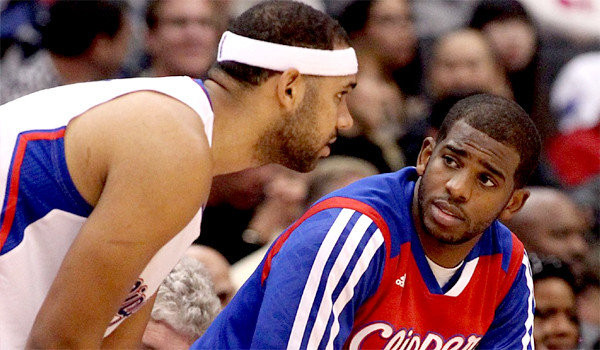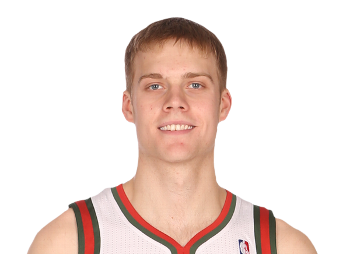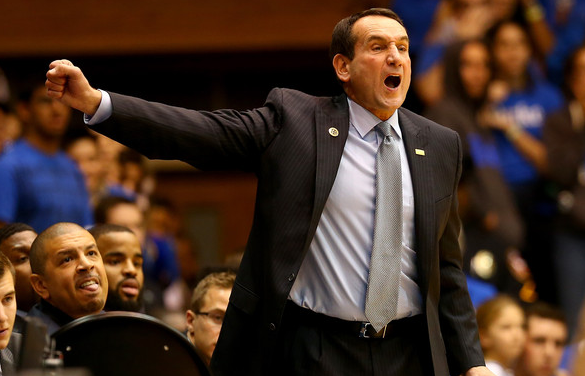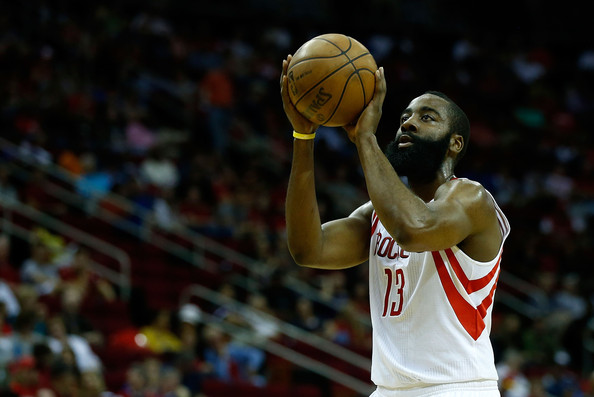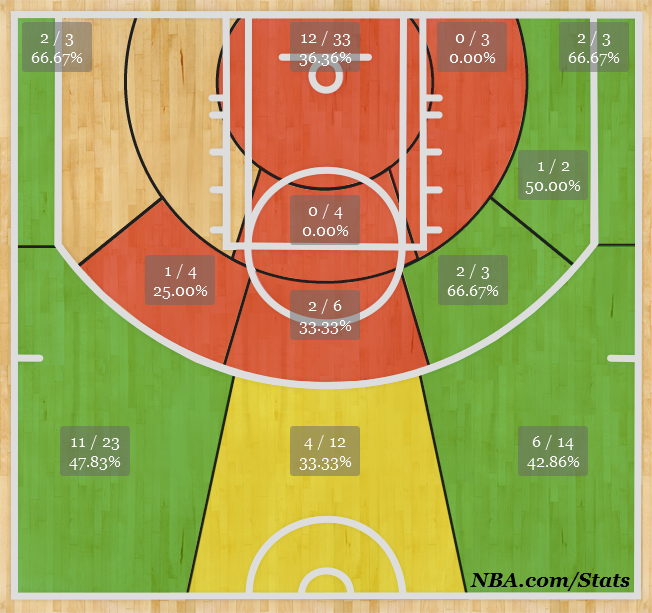Trendspotting: Christmas Holiday Edition!
Posted on Wed 25 December 2013 in Uncategorized by Aaron McGuire
Hey, all! This season, I've been working with an on-again off-again trendspotting feature that sifts through NBA data and spits out some interesting trends-to-date. Given the NBA's long-held tradition of Christmas day goodies, I decided to refrain from doing a normal version of the column this week, instead aiming to go over a trend of note for each team playing in today's action, as well as a short blurb on what these two trends may mean when they collide. So much fun! The trendspotting feature (with sourced trend-tracking and the rest) will return next week. Please enjoy this college try at a Christmas post. Be gentle!
• • •
GAME #1: CHICAGO at BROOKLYN -- Lineup Trouble! (via NBAWowy.com)
CHICAGO: For Chicago fans, this season represents -- effectively -- the darkest possible timeline. Derrick Rose went down 10 games into the season over a month ago. Guess what lineup is STILL the Bulls most used lineup, over a month later? Rose/Butler/Deng/Noah/Boozer. It was used for 129 minutes of NBA action this year -- their next-most-used lineup is Hinrich/Snell/Deng/Noah/Boozer (around 80 minutes), which isn't quite what Chicago fans had in mind when visions of title teams danced in their preseason heads. The worst part? Although it was borderline unwatchable, that Rose/Butler/Deng/Noah foursome wasn't bad at all, scoring 1.06 PPP and allowing 0.95 PPP, rates that would translate to a title team over a whole season. Even with Rose's struggles, the lineups worked decently well -- teams respected Rose's offense and the defense was, as expected, vicious. Chicago's problem this year has been depth, and the fact that just about everyone on the court after those four guys has been disappointing and mired in barely-rotation-player status. Thibodeau is trying his best to find something that works, but his scrabbling is akin to a sous chef on Chopped being handed a bag of dog poop and asked to incorporate it into a beautiful dessert. There really aren't too many outs, there.
BROOKLYN: So, you know all that talk about Chicago's best lineups? Brooklyn's best lineups haven't been nearly as effective on the court, but it's hard to really get a grip on any of them, because none of them have played. Look at this semi-hilarious, semi-depressing list of "top" lineups that the Nets have put out this season:
Williams, Johnson, Pierce, Garnett, Lopez (175 possessions, 89.6 minutes) Williams, Johnson, Pierce, Blatche, Lopez (114 possessions, 54.0 minutes) Livingston, Johnson, Pierce, Garnett, Blatche (76 possessions, 40.0 minutes) Williams, Anderson, Johnson, Garnett, Lopez (75 possessions, 39.6 minutes) Livingston, Anderson, Pierce, Plumlee, Blatche (66 possessions, 34.1 minutes)
I can hear your response now. "Are you kidding? Is this a joke?" Nope, no jokes, just rough chuckles. In a single game, any particular top-rung lineup that's versatile to be used non-situationally can usually muster around 5-10 minutes. Forty minutes of action for their best non-Lopez lineup is just kind of ridiculous at this point. Kidd has been going more than a little bit nuts on the lineup combinations (click on the "units" tab) while desperately searching for something that works. He hasn't quite found it yet. Obviously.
WHAT TO EXPECT? A really depressing game that makes you want to start drinking heavily before anyone opens presents. M*A*S*H unit lineups juggled by overwhelmed coaches. Incredibly slow pace. The dawning of the Shirsey. "Wojbombs over Baghdad."
• • •
GAME #2: OKLAHOMA CITY at NEW YORK -- Assist Opportunities (via NBA's Stat Site)
OKLAHOMA CITY: Although we don't have SportVU data available for any earlier season, one thing I've noticed from Oklahoma City's offense is that in the aftermath of the Harden trade they've tinkered with their offense in such a way that imitates the style they toyed around with during their coming-out party in the 2012 Western Conference Finals. What I mean by this is simple -- more passing, less isolation (although they're still very good at it and do it more than most teams), and more of a concerted effort to set up their fellow man. Since there's no baseline for comparison here, I could be completely wrong. But I have to think that Oklahoma City's average "assist opportunities" total has gone up over the years.
SportVU classifies an "assist opportunity" as the number of passes per game a player throws that could result in assists if their teammate makes the shot. Essentially, it allows fans to put a number to the "wow, ____'s teammates aren't making ANYTHING!" supposition that gets thrown around from time to time. Oklahoma City produces, as a team, 42.8 assist opportunities per game. This produces 21.8 vanilla assists per game (IE, assists as generally defined -- a made shot off of a pass) and 2.68 "free throw" assists per game (IE, non-counted assists where the target of the pass goes to the line). That means that Oklahoma City is converting on 24.4 of their 42.8 assist opportunities per game, producing points on 57% of their explicit passing plays. When the Thunder are passing within the flow of their offense, they're a ridiculously dangerous team.
NEW YORK: ... then again. There are a lot of NBA statistics that don't inform as to the team's quality so much as they inform to the style the team plays with. Assist opportunities -- a devilishly interesting statistic -- seems to fall under "play style" category if you look at it without context. I say this mostly because despite the rotating campfire spit of carnage that is their point guard position, the Knicks actually generate slightly more assist opportunities per game than Oklahoma City. They generate 43.7 plays that would be considered assists if the recipient canned the bucket. The big difference between New York and Oklahoma City, and the context that makes the statistic meaningful? The Knicks don't make the shots. Out of those 43.7 assist opportunities a night, the Knicks convert a baffling 20.2 of them into actual buckets and only 1.2 of them into free throws, which leads you to a conversion rate of 48%. Because we're crudely shoehorning in free throw percentage into the assist opportunities, we can't really compare this directly with field goal percentage. But that's not a particularly good number when you consider that assists are generally supposed to be the most open, high-quality shots a team can generate. This probably will improve when Prigioni and Felton are back to playing big minutes, but for now, if you're wondering about why New York's offense is so poor, you might do well to look at the plays where they're trying to set up their teammates.
WHAT TO EXPECT? Terrible traffic, if you live in the New York area. Seriously, games in both New York arenas? This slate is a gift for all the Jewish hoop-heads in New York, but I feel bad for their traffic congestion right now. Regardless. I didn't go into defense here, but the Knicks are a decidedly bottom-tier defense with poor fundamentals and still-recovering-from-injury centerpieces. Expect the Thunder to have a bunch of assists and a bunch of makes, at least for today.
• • •
GAME #3: MIAMI at LOS ANGELES -- __Confounding_ Rebounding (via Basketball Reference)_
MIAMI: This hasn't gotten a lot of press this year to date, and for good reason -- it's not particularly interesting. But one of the things that's separated this year's Miami team from the Heat of year's past is an attempt to take a page out of the shared dynasty Spurs/Celtics playbook and -- essentially -- completely abandon offensive rebounding. At no point in their dynasty have the Heat been a particularly incredible team on the offensive glass, mind you. They were 19th in the league the year they got together and stayed around that range for the following few years. This year, though? The Heat are only rebounding 18% of their own misses, which is on pace for the lowest percentage in NBA history. Look at those teams they're beating! Isn't that wild?
LOS ANGELES: Conversely, the Lakers have been one of the worst rebounding teams all season. Seriously. The Lakers are currently rebounding 71.6% of their opponent's misses, which ranks them as the 29th worst rebounding team in a league of 30. For those counting, that translates to a 28.4% offensive rebound rate among teams that play the Lakers. This isn't nearly as historically unprecedented as Miami's abandonment of the offensive glass, nor is it even particularly rare. There are 736 teams in the history of the NBA that have been worse at rebounding than the Lakers, which isn't actually all that many in the grand scheme of things over a 60 year history, but it's enough that it isn't notorious. Still, kind of hilarious.
WHAT TO EXPECT? Apologies to Nick Young, but this particular confluence of stats is the most interesting thing about this dismal afternoon game to me. When you face one of the worst offensive rebounding teams in the league -- one that, I might remind you, is doing it on purpose in an effort to shore up their defense! -- against one of the worst defensive rebounding teams in the league, which trend holds up? Does the better team decide to abandon their broader offensive rebounding strategy in favor of taking advantage of their opponent's flaws, or do they give the Lakers the rebounds they don't usually get? Should be a lot more interesting than the game itself, which is likely to be a yawner.
• • •
GAME #4: HOUSTON at SAN ANTONIO -- Picking up the Pace (via Basketball Reference)
SAN ANTONIO: The Spurs haven't changed much as the season has gone on. With Leonard and Splitter out for large stretches, the Spurs defense hasn't looked quite as good as it did to start the season. But the fundamentals -- their offensive efficacy, their pace of play, their general style -- has remained the same. You know what's changed? THE LEAGUE!
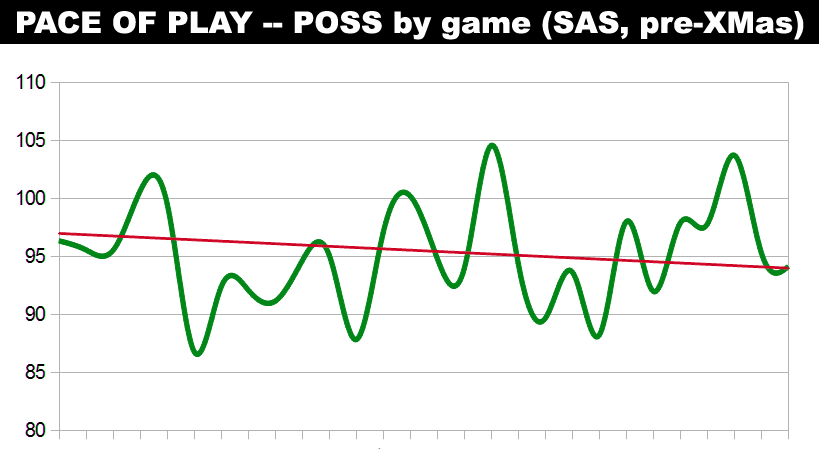
This is graph of the Spurs game-by-game pace (NOTE: it's incredibly poorly presented, and I apologize for that -- testing out a new graphing feature and can't figure out why it smoothed out the lines. This is not a smoothed average curve, it's a game-by-game graph that shouldn't be smoothed), juxtaposed with a rough graph of the league's pace over the last two months. (It's very rough. It is a line connecting two points. Realistically, I know the league's pace got down to 95 within 1 month has stayed solid at 94 for the past 3-4 weeks, so it isn't ENTIRELY correct -- it's good enough for our purposes, though.) As the season has gone on, the league's average pace has gone down precipitously. At game seven or so, the Spurs were a bottom-10 team in pace. But by staying where they were while the league dropped off, they've now transitioned to a top-10 team in pace. Which should make this a ridiculously fast game, because...
HOUSTON: ... the Rockets are sixth overall in pace! The two teams accomplish it very differently, but both err on the side of a fast game of basketball. The Spurs tend to do so by shooting quickly and forcing a lot of turnovers. The Rockets tend to do so by shooting an ungodly amount of free throws (a bit under one free throw for every two shots), which raises the statistical pace of the game while adding time to the game itself. It's one of the funniest quirks about pace factor and possession statistics, actually. The teams that create fast pace through free throws tend to essentially make the game significantly longer in real-life, slowing down the pace-we-watch-at in order to raise the pace-they-play-at.
WHAT TO EXPECT? A fast paced contest. The Rockets are bad at taking care of the ball, in general, so look for San Antonio to push the pace and get out in transition quite a bit. Look for the Rockets to try and force the Spurs to foul and send them to the line, and look for Popovich to employ hack-a-Howard if Houston's offense gets into any kind of rhythm. Should be fun, if Harden can play.
• • •
GAME #5: LOS ANGELES at GOLDEN STATE -- Lineup Anti-Trouble! (via NBAWowy.com)
GOLDEN STATE: Remember how we started this piece by talking about all the sad trouble the Bulls and the Nets have had keeping lineups on the floor? The Warriors and the Clippers could not possibly be more different from them. Although Golden State has dealt with injury issues, specifically in the loss of Andre Iguodala, they've had Iggy's services for enough of the season to use him well. Coach Jackson has had the luxury of playing Golden State's crazy-good lineup of Curry/Klay/Iguodala/Lee/Bogut for 270 minutes so far this season. And it's a pretty amazing lineup, too -- the Warriors have put up an offensive rating of 116 with that fivesome along with a defensive rating of 99, which points to a lineup that's been absolutely DESTROYING every team in the league that doesn't start Patty Mills. (Sorry, sorry. That was rude.)
LOS ANGELES: On the other side we have the Clippers, who've had similarly good health luck prior to Redick's injury. Their most-used lineup included Redick, but still was able to put in almost 300 minutes of action before he went down, which is kind of incredible. Still, their next-best lineup is hardly chopped liver, with Paul/Crawford/Dudley/Griffin/Jordan having played 160 minutes and Paul/Green/Dudley/Griffin/Jordan having played 126 minutes. Neither of these lineups have been as killer as Golden State's best-five, which points to Golden State's advantage here -- they get to play a prime-time Christmas home game against a slightly injured competitor whose best lineups haven't been as rock-solid as theirs.
WHAT TO EXPECT? The best game of the night. Last time these two met, the Clippers got a solid victory in a 126-115 offensive masterpiece. I don't expect things are going to be quite as easy this time, given that the Warriors have improved their defensive rotations after a back-and-forth first week and J.J. Redick gave the Clippers a huge boost (although his numbers sounded pedestrian -- 17-5-2 in 28 minutes and 11 shots -- the Clippers played WAY better with Redick on the floor, their spacing effectively perfect and Redick's pressure defense effective in keeping Klay Thompson out of his comfort zone). Don't expect a defensive slugfest between these two -- expect two unbelievable offenses operating at maximum efficiency, and a fitting nightcap to what's hopefully an excellent Christmas.
• • •
Have a wonderful holiday, everybody!
Continue reading

